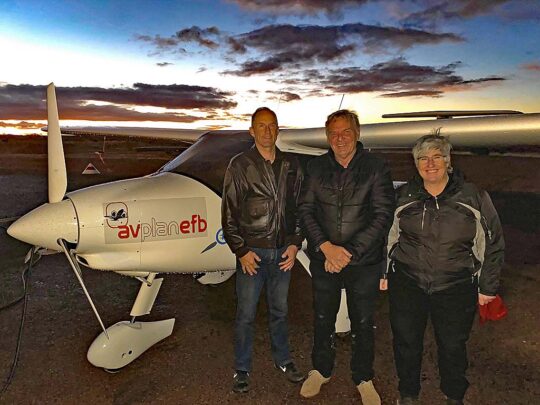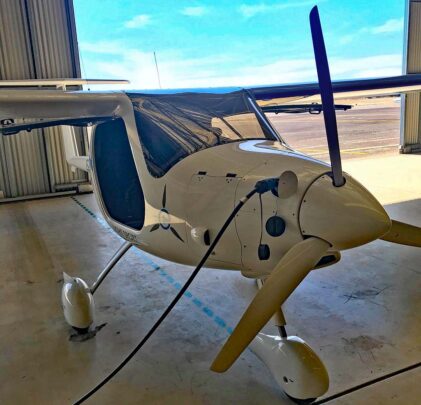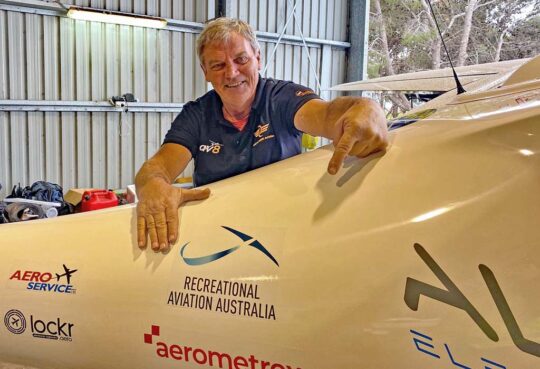“WE DID IT!” boasted the team from down under!

Pipistrel distributor Michael Coates, wrote, “South Australian-based Eyre to There Aviation … Flying a Pipistrel Alpha Electro plane, arrived in Port Augusta late yesterday (Friday June 25) after breaking the previous mark of 750 kilometers on the leg between Shoalwater Point Station and Whyalla.”
Lead by Eyre to There Aviation Managing Director, Barrie Rogers, the team will continue to Adelaide aiming to fly 1,350 kilometers by the end of the journey.
More than Distance
“Along the way, the team has also broken other world records for electric aircraft,” Coates reported, “including longest over-water flight (30.8 kilometers); furthest distance in a 24-hour period (330 kilometers); and fastest speed between waypoints (177 kilometers per hour ground speed).”

“It’s been a mammoth effort by everyone involved to achieve this incredible feat,” Barrie said. “The weather hasn’t exactly been on our side. We had ice on the wings one morning and were grounded in Port Lincoln due to an intense low pressure system.” One of the criticisms leveled at battery power is a loss of energy in cold conditions so the Eyre to There has been doing additional proving of the propulsion concept.
“On the plus side, the aircraft and the recharging systems have held up incredibly well, said Barrie. “It has gone a long way to proving the endurance and reliability of the Pipistrel Alpha Electro plane.”
“Because we can only fly about 125 kilometers (78 miles) before having to recharge, we’ve been landing in some pretty remote locations.”
As reported earlier, Barrie said Pipistrel Alpha Electro is the first and only serially-produced electric aircraft currently approved in Australia for flight training by the Civil Aviation Safety Authority (Australia’s FAA counterpart).

Showing off some of the sponsors that supported the flight, lead by AvPlan EFB and Aerometrex.
“This record attempt will further demonstrate the overall viability of this aircraft,” Barrie added. “Electric aircraft are cheaper to buy, cheaper to run, significantly quieter and don’t rely on fossil fuels. They are ideally suited for short range flight training activities.”
Eyre to There Aviation anticipates one day setting up an assembly line of Alpha Electros in Adelaide producing up to 40 aircraft per year, Barrie said.
The team will continue but from here forward, with one record claim in its logbook, Electro will be adding to its achievements.
You can follow the flight on Eyre to There Aviation’s Facebook page.


Mr. Brendo Patrick, I love you!! And thanks for the succinct response. Wonderful!! Except my interest is in the Opener BlackFly. All airports are too busy for me. I have petitioned the FAA for an exception to 14 CFR 103.15 no flying in congested areas. AOPA and FAA statistics show that aircraft are up to 3 times safer than autos. Based on the US constitution commerce clause and equal protection under the law; the FAA mandate is solely safety and since aircraft are safer than autos; no reason exists for the BlackFly to not fit into traffic. And besides, not only my garage but everyone”s garage is a better place to a keep a roadable aircraft like the BlackFly. The BlackFly has 34,000 test flight hours on it. Airliners are retired with 20,000 to 30,000 flying hours. How well the BlackFly has been tested. Only biplanes that keep their wing span under 14 feet are acceptable to me and that are relatively uncomplicated like the Blackfly. As a long time pilot, engineer, and A&P; I recognized you can talk about anything you like; but if not in my interest you will not have my ear and not have lots of other people’s interest. Mr. Johnson likes to talk about affordable aircraft mostly; which leaves out most of the evtols at evtol. The BlackFly by Opener has a suggested price similar to an SUV; a large range; and we will not know that price until this fall. But is less expensive than all other SLSAs; as near as I can tell. Keeping the conversation relevant to me and to many others is my goal here because the preponderance is talk about aircraft that need airports; just a not, not, not, for me.
I don’t understand what endurance record is being achieved here.
In my mind, an endurance record would be a single flight of long endurance, but the article says they’re flying only 125 km on each leg. Is one of the legs an endurance record?
Or, is the entire trip an “endurance record?” They’re chaining together legs until, taken together, the legs exceed the distance traveled by any other electric aircraft in its life? So, 1,350 km is the longest distance ever flown, in its life, by an electric aircraft?
You pose some interesting questions. Assuming the Australian group will seek FAI acceptance of their record attempt, it will follow well-defined rules for such things. For now, we cannot regard this as anything more than a marketing effort until they successfully complete their task and are awarded a record.
Nonetheless, it is a significant achievement, one that took lots of planning, preparation, and personnel.
Also, I would note for you that when an aircraft flies around The world, it is accepted as a round-the-world flight even though they stop multiple times. Is this so different?
How is electricity generated in Oz? Does that process consume fossil fuels? Coal? Oil? Natural Gas?
While those are valid questions, the article was focused on the airplane and propulsion system, not its “greenness.”
What’s “greenness”? You don’t have to answer that, it’s a rhetorical question. The point asking the question how electric power is generated is the statement, “Barrie added, ‘Electric aircraft are cheaper to buy, cheaper to run, significantly quieter and don’t rely on fossil fuels.'” Really?
Mr. LeMarr, While I agree with you electric aircraft are not cheaper to fly, or cheaper to run. The only way to get the Greenies out of our lives is to lull them to sleep. They will not go away with their political correctness; no matter how wrong it is. The real question is: How do you get people to focus on the facts and reality and give up on political correctness? It probably is not possible because most of them have no STEM training and while they think they have answers; they do not based on STEM where you find facts and reality. Based on my training, half of all STEM trained people have little or no M, math training; the starting point of all facts and reality. So it is a much more complex problem than it appears. A problem we will have to learn to live with; unfortunately; and find ways around these pseudo intellectuals. They are at least half of the faculty at most universities; real problem people. And they spend most of their lives brushing off the STEM faculty; just an ugly problem.
Terry, buddy, what on earth about this article would incite a tirade about “greenies” and their lack of “STEM education”? I fear for your blood pressure. I’m sure you’re normally an easy-going, fun-loving kind of guy – maybe a few days away from the internet would restore your usual charm?
To address the half-dozen words of your post that might actually pertain to the article at hand, there’s really no need to make speculative jabs about the cost of electric airplanes. You are likely aware that the internet is more than a venue for sweet intellectual takedowns of STEMless greenies, but that it’s also quite handy for personal research – I dare say that was once its chief purpose.
Barely a minute of Googling and you could find that the airplane referenced in the article, the Pipistrel Alpha Electro, retails for roughly $140k brand new. That’s pretty comparable to the Cessna 162 (before the 162 was canceled five or six years ago) and is considerably less than any brand new 172 Skyhawks. If you know of any new Skyhawks going for less than a quarter-million then clue me in, brother man! I think I know some fellas with more change in the coin jar than myself who would be all over that find.
It also seems like these Pipistrel electrics are *actually* commercially available, unlike so many much-touted electric concept planes of the past decade – it has been in production in Italy since 2015 and actually won FAA airworthy approval in 2018. A flight school in California appears to be using a few of them for lessons now. And before you raise any torches or pitchforks over the honesty of those no-good paisanos and their BS electro-socialist propaganda, you might consider that the Pipistrel Alpha was initially built with a “normal” av-gas sipping internal combustion powerplant, and that the gas-powered version is still manufactured and sold alongside the electric. It seems to me the company has little reason to lie about the electric plane’s cheaper operation, and if you dare to venture a bit further on the old Google journey, you’ll find loads and loads of . The big barrier to tackle now is, of course, range, but it would seem that the era of the electric airplane might well be dawning as we speak. Let’s keep it on the hush-hush though, lest any of those greenies emerge from their calculus-deprived hobbit holes to blockade our streets, lock arms and sing kumbayah.
in the area where these guys are based it is mostly solar with a secondary supply of coal. Remember, Elon Musk put in the largest battery system in the world in the area that this flight took place.
https://www.popularmechanics.com/science/a31350880/elon-musk-battery-farm/
Australian households are big users of solar energy. It is the enormous distances that we need to move things that makes us a high user of fossil fuels.